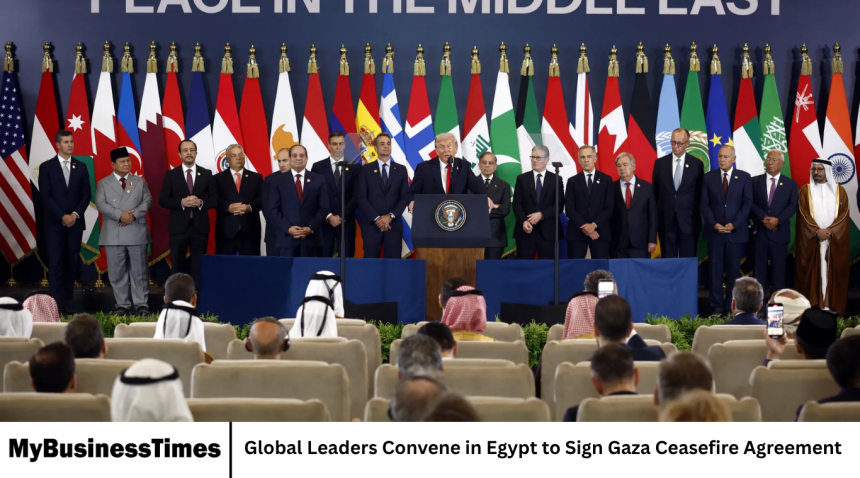World leaders recently gathered in Egypt to sign a ceasefire agreement aimed at ending the ongoing violence in Gaza. The meeting brought together diplomats and officials from various countries to address the humanitarian crisis and restore stability in the region. The event highlighted the importance of international cooperation in resolving conflicts.
The Gaza conflict has caused widespread suffering, including loss of life, destruction of property, and displacement of civilians. The ceasefire agreement represents a collective effort by the global community to prevent further escalation and promote peace. Observers hope that this agreement will lead to lasting stability in the region.
Background of the Gaza Conflict
Gaza has been a focal point of conflict for many years, with tensions between different political groups and neighboring countries. The conflict has resulted in repeated outbreaks of violence, affecting thousands of civilians and creating a severe humanitarian situation. International organizations have repeatedly called for dialogue and conflict resolution.
The region’s political, economic, and social challenges have made it difficult to achieve lasting peace. Past ceasefires have often been temporary, with hostilities resuming after a short period. This context makes the current gathering of global leaders particularly significant.
Purpose of the Ceasefire Agreement
The ceasefire agreement aims to halt hostilities and create conditions for peace negotiations. Leaders involved in the signing emphasized the importance of protecting civilians and ensuring humanitarian aid can reach affected areas. The agreement also seeks to address the root causes of conflict, including political disputes and security concerns.
By bringing multiple countries together, the agreement demonstrates the global community’s commitment to stability in Gaza. Coordinated efforts are essential to prevent future violence and promote long-term solutions for peace.
Participants in the Meeting
The meeting in Egypt included leaders from several key countries, regional representatives, and international organizations. Diplomatic representatives played a crucial role in mediating discussions and drafting the terms of the agreement. Egypt’s government hosted the event, facilitating dialogue among participants and ensuring a neutral environment for negotiations.
Observers noted that the presence of global leaders helped build trust and reinforced the importance of collaboration in conflict resolution. Such gatherings are often essential for reaching consensus on complex political issues.
Key Provisions of the Agreement
The ceasefire agreement includes several important provisions aimed at reducing violence and protecting civilians. These include the immediate cessation of hostilities, mechanisms for monitoring compliance, and plans to facilitate humanitarian aid. The agreement also calls for renewed dialogue to address underlying political issues.
Leaders stressed that adherence to the agreement is crucial for its success. Regular monitoring and reporting mechanisms have been established to ensure that all parties comply with the terms of the ceasefire.
Humanitarian Implications
The ceasefire agreement is expected to have a significant humanitarian impact. It will allow aid organizations to provide food, medical care, and other essential services to affected populations. Reducing violence also helps protect schools, hospitals, and infrastructure, which are often damaged during conflicts.
International agencies have welcomed the agreement and pledged support for its implementation. The ceasefire is seen as a critical step toward addressing the urgent needs of civilians in Gaza.
Regional and Global Reactions
The agreement has received positive reactions from countries around the world. Many leaders praised Egypt’s role in hosting the talks and facilitating dialogue. Regional governments expressed hope that the ceasefire will lead to long-term stability and prevent further escalation.
Global organizations, including the United Nations, emphasized the importance of cooperation and adherence to international law. The agreement reflects the shared responsibility of the international community to address conflicts and protect human rights.
Challenges to Implementation
Despite the positive outcome, challenges remain. Past ceasefires in Gaza have been fragile, with violations occurring shortly after agreements were signed. Maintaining trust among parties, ensuring compliance, and addressing underlying political disputes are critical to the success of the current ceasefire.
Leaders have acknowledged these challenges and emphasized the need for continued engagement, monitoring, and support from the international community to ensure the agreement’s effectiveness.
Frequently Asked Questions
What is the Gaza ceasefire agreement?
It is an agreement signed by global leaders to halt hostilities in Gaza and promote peace and humanitarian relief.
Who participated in the signing of the agreement?
Leaders from multiple countries, regional representatives, and international organizations attended the meeting in Egypt.
What are the main goals of the agreement?
The agreement aims to stop violence, protect civilians, provide humanitarian aid, and address underlying political disputes.
How will the ceasefire be monitored?
Monitoring mechanisms have been established to ensure all parties comply with the terms of the ceasefire.
What challenges could affect the success of the agreement?
Past ceasefires have been fragile, so maintaining trust, addressing political disputes, and preventing violations are key challenges.
Conclusion
The gathering of global leaders in Egypt and the signing of the Gaza ceasefire agreement represents a significant step toward ending violence in the region. While challenges remain, the agreement provides hope for civilians affected by conflict and demonstrates the importance of international cooperation in achieving peace. Continued efforts, monitoring, and dialogue will be essential to ensure lasting stability in Gaza.








